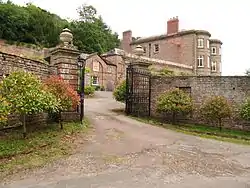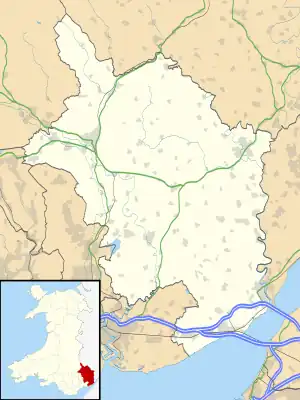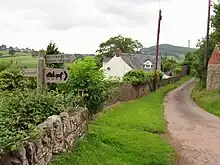| Newton Court | |
|---|---|
 | |
 Location within Monmouthshire | |
| General information | |
| Architectural style | Neo-classical |
| Location | Monmouth, Wales |
| Coordinates | 51°49′32″N 2°41′39″W / 51.8255°N 2.6943°W |
| Elevation | 80 m (262 ft) |
| Construction started | 1799 |
| Completed | 1802 |
| Technical details | |
| Floor count | 3 |
| Design and construction | |
| Architect(s) | Anthony Keck |
Newton Court is a neoclassical house, completed in 1802, situated on the hillside above Dixton, 1 mi (1.6 km) north-east of the town on Monmouth, in Monmouthshire, Wales. It is a Grade II* listed building.[1] The stable block is listed as a Site of Special Scientific Interest (SSSI), noted for as a breeding site for lesser horseshoe bats.
History
Early land use
The first major activity on the land, other than evidence of a few prehistoric flints, was in the medieval period, with pottery finds and indications of iron smelting. The Doomsday Book mentions that a mill might have been present in the area. Industry continued through to the post-medieval period, with kiln waste being found.[2]
A 14th-century manor house was present in the area, possibly on the site of the present-day Newton Court.[2]
Construction
The land for Newton Court, on a south-east facing hillside, was purchased by Admiral Thomas Griffin in the 18th century at the same time as the land at Hadnock and was left to his third son, George Griffin, after his death.[2] Under George, Newton Court was constructed between 1799 and 1802, possibly to the designs of architect Anthony Keck of King's Stanley in Gloucestershire, who died prior to its commencement.[3]
The three-storey house was built in the neoclassical style, using coursed red sandstone with Forest of Dean stone dressings and a slate roof.[2][3][4]
Usage to present day

The house remained in the Griffin family at least until 1901, when according to Kelly's Directory of Monmouthshire it was "the seat of George Griffin Griffin esq., M.A., D.L., J.P."[5]
The house, stables, and screen wall were listed as Grade II* listed buildings in 2005,[1] whilst the gate piers, gates, and wing walls were Grade II listed in the same year.[6]
Newton Court Farm is situated at the end of Newton Court Lane and in between this and the house is the older 17th-century Newton Hall, which is a Grade II listed building.[7][8]
Stable Block

Newton Court Stable Block is noted as a small SSSI, totalling 2.3 ha (5.7 acres) in area; it comprises the stable block, which is also a Grade II* listed building,[1] the courtyard and neighbouring woodland.[9] It is of importance because it is the only breeding colony in Monmouthshire for the nationally rare and endangered greater horseshoe bat (Rhinolophus ferrumequinum) and one of only three known sites in Wales. Between 50 and 100 adult and flying young have been recorded on the site, using the stable roof space for nesting. The stable block is also used by a few lesser horseshoe bats (Rhinolophus hipposideros).[10] The SSSI forms part of the Wye Valley and Forest of Dean Bat Sites Special Area of Conservation.[11]
The stable block building has previously undergone a number of temporary maintenance improvements, but as of 2012 is in a state of disrepair.[12]
References
- 1 2 3 Cadw. "Newton Court, including attached stable buildings and screen wall to stable court, Monmouth (Grade II*) (85215)". National Historic Assets of Wales. Retrieved 18 April 2022.
- 1 2 3 4 "Lower Wye Valley: Newton". Glamorgan-Gwent Archaeological Trust. Retrieved 12 June 2012.
- 1 2 Newman, John; Manning, William; Hughes, Stephen (2000). The Buildings of Wales: Gwent/Monmouthshire. London: Penguin Books. p. 216. ISBN 0-14-071053-1.
- ↑ "Newton Court (222528)". Coflein. RCAHMW. Retrieved 18 April 2022.
- ↑ "Kelly's Directory of Monmouthshire 1901". Kelly's Directories Ltd. Archived from the original on 23 October 2012. Retrieved 13 December 2013.
- ↑ Cadw. "Gatepiers, Gates and wing walls at Newton Court, Monmouth (Grade II) (85201)". National Historic Assets of Wales. Retrieved 18 April 2022.
- ↑ Ordnance Survey: Explorer map sheet OL14 Wye Valley & Forest of Dean ISBN 9780319240953
- ↑ Cadw. "Newton Hall, Monmouth (Grade II) (85216)". National Historic Assets of Wales. Retrieved 18 April 2022.
- ↑ "Newton Court Stable Block map" (pdf). Countryside Council for Wales. Retrieved 12 June 2012.
- ↑ "Newton Court Stable Block" (pdf). Countryside Council for Wales. Retrieved 12 June 2012.
- ↑ "Wye Valley and Forest of Dean Bat Sites". Countryside Council for Wales. Archived from the original on 23 December 2012. Retrieved 12 June 2012.
- ↑ "Newton Court Stable Block Site Management Statement" (pdf). Countryside Council for Wales. Retrieved 12 June 2012.